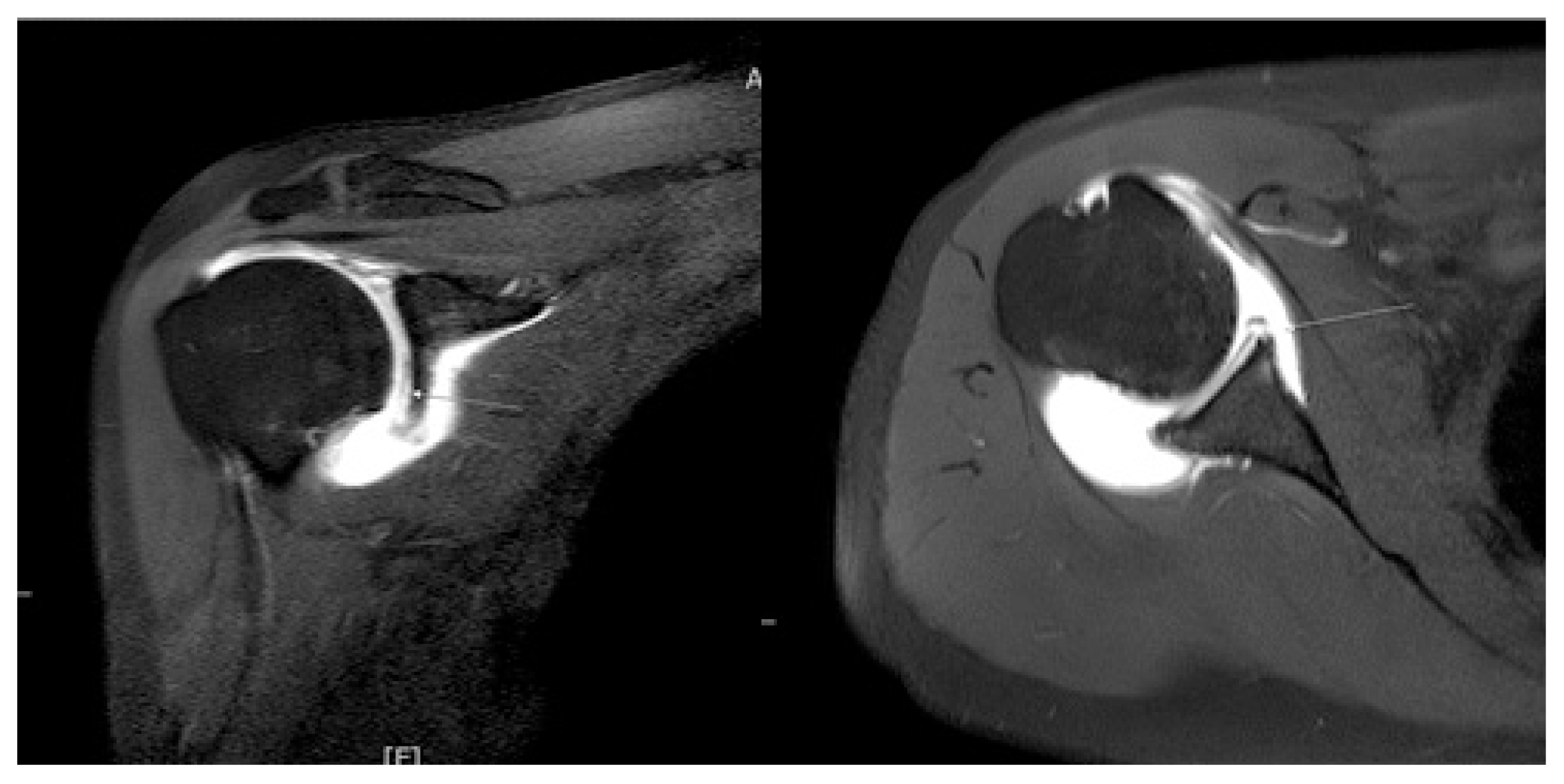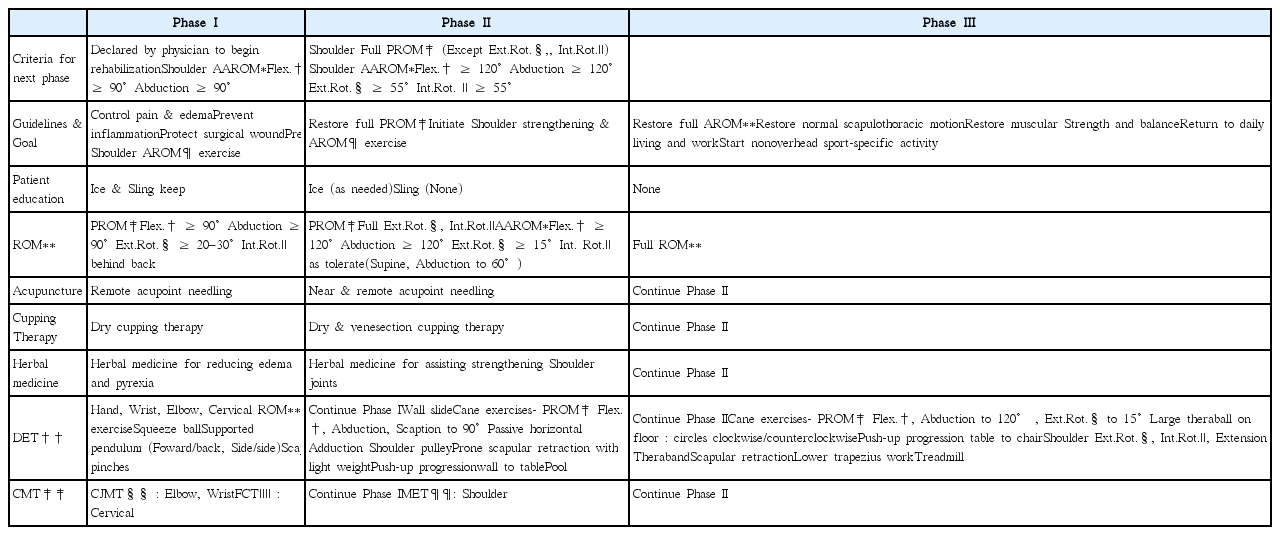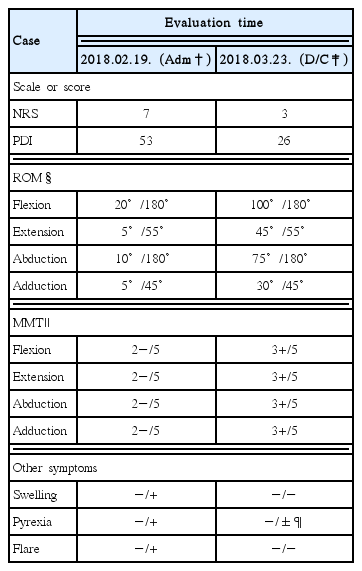References
1. Jeong MS, Jeon JM, Tae SG, Oh JH. The shoulder Surgery 1st ed.th ed. Seoul: Koonja Publishing Co; 2010. 141p. 288p. 292p. 295p. 297–8.
2. Adams JC. Recurrent Dislocation of the Shoulder. J Bone and Joint Surg 1948;30–B:26–38.
3. Choi CH, Kwun KW, Kim SK, Lee SW, Shin DK, Kim KM. Bankart suture repair for anterior instability of the shoulder: results of arthroscopic versus open repair. J Korean Shoulder Elbow Soc 2002;5:47–54.
4. Kim YS. Rehabilitation after Bankart and SLAP repair. Journal of Korean Arthroscopy Soc 2008;12(2):75–81.
5. Noh HK, Park JW, Lee JI, Park JH. Result of early active range of motion exercise after bankart repair of traumatic anterior instability. Jourmal of the Korean Fracture society 2007;20(1):53–7.
6. Lee JH, Ko MK, Yoon KS, Lee CW, Kim YI, Kim JH. Case report of acute traumatic rotator cuff tear treatment in traditional korean medicine. Jourmal of pharmacopuncture 2011;14(4):53–8.
7. Yeom SR, Song JH. Calcific Tendinitis of the Shoulder by Oriental Medical Treatments : 4 Cases Report. J Oriental Rehab Med 2010;20(1):209–17.
8. Song MY, Jo HG, Sul JU, Leem JT. Proposal of East-west Integrative Medicine manual for Rehabilitation after shoulder surgery. Journal of Korean Medicine Rehabilitation 2018;28(1):109–20.
9. DeFroda Steven, Mehta Nabil, Owens Brett. Physical Therapy Protocols for Arthroscopic Bankart Repair. Sports health 2018;:10.
10. Lee KO, Kuk YB, Yun YG. Effects of Jakyakgamchotang extract on the Analgestic effect in Mice. Korean J Oriental Medical Prescription 2003;11(1):161–70.
11. Kim BW. Anti-inflammatory effect of Jakyakgamcho-tang. Korean J Orient Int Med 2010;31(2):365–71.
12. Korean Society of Chuna Manual medicine for Spine & Nerves. Chuna manual medicine 2.5th Edth ed. Seoul: Korean Society of Chuna Manual medicine for Spine & Nerves; 2017. p. 101p. 222–30.
p. 262p. 282–4..
13. The Society of Korean Medicine Rehabilitation. Korean Rehabilitation Medicine 4th edth ed. Seoul: Koonja Publishing Co; 2015. 3p. 100p. 404–5.
p. 413–6.
14. Haerer AF. The neurologic examination 5th edth ed. Philadelphia: JB’ Lippincott company; 1992. p. 335–74.
15. Shim SY, Park HJ, Lee JM, Lee HS. An Overview of Pain Measurements. The Korean Journal of Meridian & Acupoint 2007;24(2):81–2.
16. Pollard CA. Preliminary validity study of the pain disability index. Percept Mot Skills 1984;59(3):974.
17. MacLaughlin HL. Recurrent Anterior Dislocation of the Shoulder. I. Morbid anatomy. Am J Surg 1960;99:628–32.
18. Reeves B. Acute Anterior Dislocation of the Shoulder. Ann R Coll SurgEngl 1989;43:225.
19. Rockood CA, Masten FA. The Shoulder 1st Edth ed. Philadelphia: W.B. Saunder Co; 1990. 1p. 230–1.
20. Bankart ASB. The Pathology and treatment of recurrent dislocation of the Shoulder Joint. British JSurg 1938;26:23–9.
21. Steven CT, Matsen FA. An approch to the repair of avulsion of the glenohumeral ligament in the management of traumatic anterior glenohumeral instability. JBone and Joint Surg 1989;71–A:511.
22. Manta JP, Organ S, Nirschl RP, Pettrone FA. Arthroscopic transglenoid suture capsulolabral repair. Am J Sports Med 1997;25:614–8.
23. Morgan CD, Bodenstab AB. Arthroscopic bankart suture repair: technique and early results. Arthroscopy 1987;3:111–22.
24. Walch G, Boileau P, Levigne C, Mandrino A, Neyret P, Donell S. Arthroscopic stabilization for recurrent anterior shoulder dislocation: result s of 59 cases. Arthroscopy 1995;11:173–9.
25. Owens BD, Hurwitz SR, Thompson TL, Wolf JM. Surgical trents in Bankart repair:an analysis of data from the American board of Orthopaedic surgery certification examination. Am J Sports Med 2011;39:1865–9.
26. Kim MK, Shin CS. Results According to Arthroscopic Repair Methods of Bankart Lesion (Operative Methods According to Labral Tear). The Journal of the Korean Orthopaedic Association 2001;36(6):525–30.
27. Michael J. Strobel Manual of Arthroscopic surgery 1st edth ed. Seoul: Gabon Publishing Co; 2006. p. 875–82.
28. St Mary’s hospital. Rehabilitation after Bankart and SLAP Repair. Journal of Korean Arthroscopy Soc 2008;12(2):75.
29. Rowe CR, Zarins B. Recurrent transient subluxation of the shoulder. J Bone Joint surg Am 1981;63:863–72.




